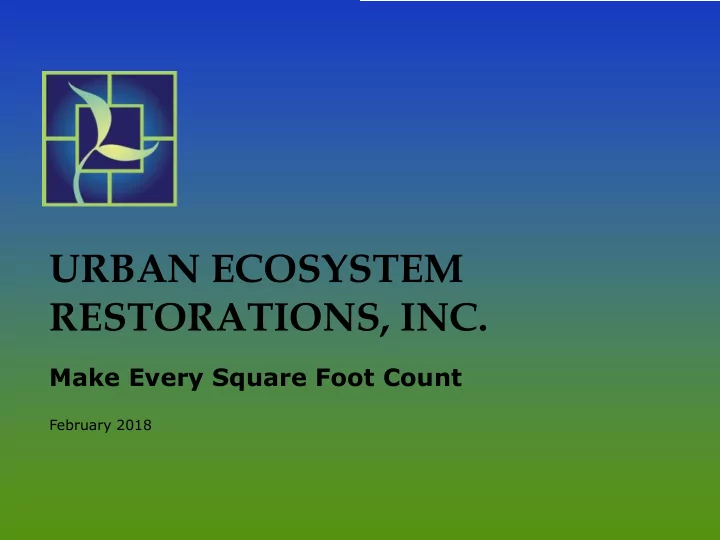

URBAN ECOSYSTEM RESTORATIONS, INC. Make Every Square Foot Count February 2018
The Economics of Eco-Functioning Spaces 2
WEBINAR AGENDA v Quick Background and Analytic Framework v Systems Thinking v Eco-Functioning Spaces v Environmental Function – Brief Summary v Social Function – Brief Summary v Economic Function – Concepts and Case Studies v Relationship to Chesapeake Bay Agreement v Questions & Answers 3
So here we are… 4
Interdependent Systems AIR Global FOOD WEBS Region BIODIVERSITY State HABITAT WATER Local CLIMATE/WEATHER 5
Predominant Land Uses Today 6
Chesapeake Bay Region – Land Use in Context Ø Historic deforestation Ø Current development Ø Parcelization Ø Invasive species Ø Deer https://www.chesapeakebay.net/issues/forests 7
A New Analytic Framework 8
E-S-E Framework & Performance Goals B4B Goals • Stormwater management • Temperature control • Clean air • Environmental Energy efficiency Property value • • Mitigates climate change Low operating cost • • Supports food webs and Safe and secure • • living soils buildings High absorption, • high retail sales Low turnover • Regulatory • Community • compliance engagement Personal • Social Economic enjoyment Spiritual/ • emotional restoration Public health • 9
Scaling Site-Based Solutions Using New Systems to Achieve E-S-E Land Use Choices Environmental become restorative and long-term: 1. Create ecologically restorative landscapes SYSTEMS THINKING 2. Strengthen occupant health Social Economic and social needs 3. Produce Net Economic Benefit 10 10
Eco-Functioning Spaces The Right Systems for E-S-E Outcomes 11 11
Eco-Functioning Spaces: Landscape systems that achieve E-S-E goals over time. 12 12
Spectrum of Eco-Functioning Spaces: Three Illustrative Case Studies Ultra urban; Suburban; highly natural engineered systems 1.The Avenue 1. 2. Ca 2. Cawrse & & Assoc ociates 3. Prairie Crossing 3. 13 13
EFS Environmental Goals Th The Foundation 14 14
Environmental Performance Abundant Life: native habitat Clean Water: Climate Change: stormwater mitigation and retention and resilience filtration Other: air/temperature improvement 15 15
Nature’s Systems 16 16
EFS Social Goals Ne Necessary for public demand and behavior change 17 17
Social Performance Ø Eco-service functions promote mental and physical health Ø Teach people about the space, and allow them to reconnect with nature , producing deep attachments to the land and building Ø Create a sense of place while maximizing eco-function – connecting people to each other Ø Design and maintain for beauty, function, and distinctiveness – they become emotionally restorative 18 18
EFS Economic Goals Es Essential for Achieving Scale 19 19
Economic Net Benefit: Life-Cycle Components Cost Reduction/ First Costs Value Creation Avoidance Risk Subsidies/OPM Management 20 20
Key Economic Variables Urban Density, Owner/Occupant Use Type Zoning & Massing Type as of Right • Residential • Commercial • Height Limit Owner-Occupied • Office • Footprint smaller • Retail • Owner-Tenant than Lot Line • Hotel • Residential • Open Space/ Owner-Occupied Green Area • Trophy Requirement • Rent-Control/ • Class A Affordable • Lot Size/Square • Class B Footage • Public Access/ • Class C Controlled • Surrounding Access Area Land Use/ Land Cover 21 21
Economics: Value and Revenue Lever 1 22 22
The Avenue: 20 Value Creation 40 20 15 10 5 0 23 23 SITE PLAN
Economics: Cost Savings Lever 2 24 24
Life-Cycle Cost and Risk Mitigation 25 25
Costs/Revenues: NOI & ROI First cost investment of $450,000 for highly engineered system with water reuse; 7% increase of rent; $20,000 cost savings for O&M and vacancy rate drops to 1%. NOI up by $117,186 ; ROI in under 4 years. 26 26
Costs/Revenues: NOI & ROI Prime location apartments; 50 units on 1.5 acres with .5 acres of old blacktop and other open space. First cost investment of $350,000 for full ecological restoration on .5 acre; 5% increase of rent; $25,000 cost savings for O&M and vacancy rate drops to 2%. NOI up by $89,134 ; ROI in 27 27 under 4 years.
Conservation Communities – Prairie Crossing, Illinois 677-acre site 60% is protected open land that is actively used by people and wildlife. more than 175 acres of restored prairies 20 acres of restored wetlands, and 16 acres of historic hedgerows part of a corridor of open space with a trail system through to Grayslake, Independence Grove and beyond via the 31-mile Des 28 28 Plaines River Trail.
Economics: Risk Management Lever 3 29 29
Risk Management: Cawrse & Assocs. Treatment train with bioswale, bio- retention, rain garden and permeable pavers. “In July 2015, there was 5 inches of rain in one hour and no flooding in the parking lot. The rain garden contained the roof runoff and the bioretention/bioswale stored rainwater and did not contribute to flooding on surrounding properties, which were under more than a foot of water” 30 30
Subsidies Le Leve ver r 4 31 31
Subsidies/Incentives Storwater management direct subsidies for green infrastructure Stormwater utility fee abatements Green banks Forest conservation banks Stormwater retention credits Crowdfunding/Nonprofit partner fundraising Special district/BID assessments Informal carbon offset fundraising Developer incentives, like increased height or density 32 32
Urban Ecosystem Restorations Ur Urban Land Trust 33 33
UER Role Supports E-S-E Goals EFS: Natural System UER: Protection, Maintenance, & Engagement Services OUTPUTS: Fresh Air, Water, Energy Efficiency, Temperature Control, Stress Management, Community Engagement and Cohesion, Community Health, Higher Rents, Lower Costs 34 34
Relationship to B4B Requirements Abundant Life (Habitats & Fisheries) Clean Water Conserved Lands Engaged Communities Climate Change Resilience Other Green Initiatives 35 35
Questions? 36 36
Thank you Rachel Toker, President & CEO rachel@urbanecosystemrestorations.org (202) 494-8562 37 37
Recommend
More recommend